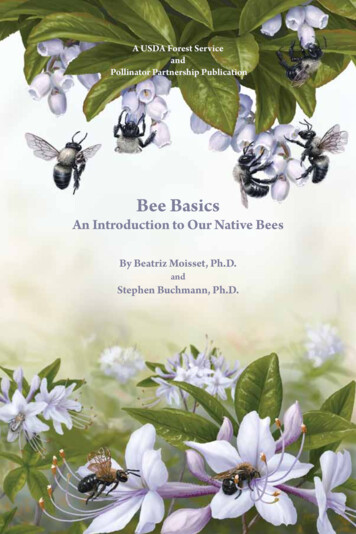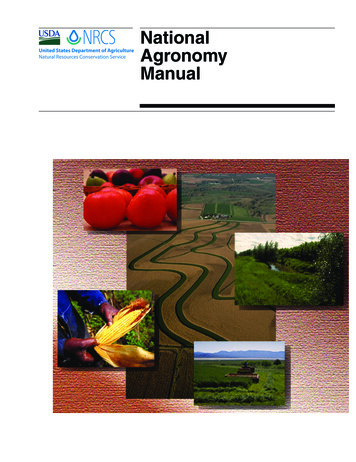
Transcription
A USDA Forest ServiceandPollinator Partnership PublicationBee BasicsAn Introduction to Our Native BeesBy Beatriz Moisset, Ph.D.andStephen Buchmann, Ph.D.
Cover Art:Upper panel: The southeastern blueberry bee (Habropoda laboriosa)visiting blossoms of Rabbiteye blueberry (Vaccinium virgatum).Lower panel: Female andrenid bees (Andrena cornelli) foraging fornectar on Azalea (Rhododendron canescens).
A USDA Forest Service and Pollinator Partnership PublicationBee Basics:An Introduction toOur Native BeesBy Beatriz Moisset, Ph.D.andStephen Buchmann, Ph.D.Illustrations by Steve Buchanan
A USDA Forest Service and Pollinator Partnership PublicationUnited States Department of AgricultureAcknowledgmentsEdited by Larry Stritch, Ph.D.Julie NelsonTeresa PrendusiLaurie Davies Adams
Worker honey bees (Apismellifera) visiting almondblossoms (Prunus dulcis).IntroductionNative bees are a hidden treasure. From alpine meadows in the nationalforests of the Rocky Mountains to the Sonoran Desert in the CoronadoNational Forest in Arizona and from the boreal forests of the Tongass NationalForest in Alaska to the Ocala National Forest in Florida, bees can be foundanywhere in North America, where flowers bloom. From forests to farms, fromcities to wildlands, there are 4,000 native bee species in the United States, fromthe tiny Perdita minima to large carpenter bees.Most people do not realize that there were no honey bees in America beforeEuropean settlers brought hives from Europe. These resourceful animalspromptly managed to escape from domestication. As they had done formillennia in Europe and Asia, honey bees formed swarms and set up nests inhollow trees. Native pollinators, especially bees other than honey bees, havebeen pollinating the continent’s flowering plants since long before the arrival ofhoney bees. Even in today’s vastly altered landscapes, they continue to do theyeomen’s share of pollination, especially when it comes to native plants.The honey bee, remarkable as it is, does not know how to pollinate tomato oreggplant flowers. It does very poorly compared to native bees when pollinatingmany native plants, such as pumpkins, cherries, blueberries, and cranberries.Let us take a closer look at this forgotten treasure of native bees.1
Native Bees: Varied and ValuableNative bees come in a wide array of sizes, shapes, and colors. They are alsovaried in their life styles, the places they frequent, the nests they build, theflowers they visit, and their season of activity. They remain ignored or unknownby most of us. Yet, they provide an invaluable ecosystem service, pollination,to 80 percent of flowering plants. What would our world be like without thebeauty of flowering trees, shrubs, and wildflowers? How many of us knowthat bees pollinate approximately 75 percent of the fruits, nuts, and vegetablesgrown in this country?Bees are efficient foragers. One example is the southeastern blueberry bee,Habropoda laboriosa, a hard working little creature capable of visiting as manyas 50,000 blueberry flowers in her short life and pollinating enough of them toproduce more than 6,000 ripe blueberries. At market those 6,000 blueberriesare worth approximately 20 or more. Not every bee that you see flitting aboutmay be worth 20, but all of them combined keep the world of floweringplants going. The world as we know it would not exist if there were no bees topollinate the earth’s 250,000 flowering plants.U.S.’s smallest bee (Perditaminima) face to face with afemale large carpenter bee(Xylocopa varipuncta).2
Bees or Wasps?Upper left: An eastern yellowjacket wasp (Vespulamaculifrons)Lower left: The familiarblack and yellow muddauber wasp (Sceliphroncaementarium)Upper right: A digger bee,in the genus DiadasiaLower right: The nomadbee, within the genusNomadaFrom Whence They Came: Bees’ HeritageBees are descended from wasps. Most wasps are carnivores; they either preyupon or parasitize other insects or spiders, and use this rich protein source tofeed their young. About 125 million years ago, when the first flowering plantsevolved, some wasps made a switch from hunting prey to gathering pollenfor their brood. Perhaps they were hunting for insects that visited flowers andate some of the pollen or drank the nectar along with their prey. It didn’t takemuch to find the advantages of consuming pollen over hunting. Pollen is richin proteins and doesn’t fight back, so it is easy to imagine why the bees becamevegetarians. Gathering pollen and nectar requires certain adaptations differentfrom those of hunters, so they started to change, to evolve to meet theserequirements and consequently became bees.Even today, there are bees that appear very similar to wasps. Like wasps,some bees are also nearly hairless; and like female wasps, only female bees havestingers.The similarities do not stop with physical appearance. Both bees and waspshave species that are solitary (living and raising their brood alone) or social(living together and sharing the rearing and provisioning). For example,bumble bees and yellow jacket wasps are social and have an annual colony. Inboth, an over-wintering queen emerges in the spring. The queen builds a nest,collects food, and lays eggs. The female workers hatch and work together tofeed and care for the colony until fall when new queens emerge, mate, andhibernate until the following spring when the cycle begins anew.3
Bee Anatomy orMorphologyLike all insects, bee bodies arecomprised of a head, thorax, andabdomen. They also have six legs andtwo pairs of wings.The head features: two antennae that are used totouch and “smell”; two compound eyes and threesimple eyes; mandibles or jaws used forbiting, working wax and pollen“loaves,” and digging.The thorax features: two pairs of membranous wings,linked in flight by minute hooks; three pair of legs.The abdomen features: six segments in females, sevensegments in males; internal wax glands (only inhoney bees and bumble bees); a stinger (modified ovipositor)at the tip (females only); branched hairs (plumose)SOMEWHERE on the body.Some females have pollen transportstructures, called scopae, made of stiffhairs located on the hind legs or underthe abdomen. Bees frequently brushthemselves, gathering pollen grainsfrom their body’s feathery hairs andtransferring the pollen grains to theirtransport structure.4
A male digger bee (Anthophoracentriformis) with major bodyparts labeled. Inset shows pollengrains caught in the branched hairsthat distinguish bees from wasps.5
Ecologically, bees can be separated into two groups based on the relativelength of mouthpart segments within their tongues, called proboscides. Thelong and short tongues are used to gathernectar.Some long-tongued bees likeApidae and Megachilidae,favor deep flowers with aA long-tongued bee(Anthophora centriformis)drinking nectar froma beardstongue flower(Penstemon parryi).A short-tongued bee in the genusColletes taking nectar from theshallow florets of a sunflower(Helianthus annuus)6
longer throat; they are not averse to collecting nectar from open flat flowers.The remaining families are made up of short-tongued bees and are morelimited in their floral choices. They are only able to take advantage of shallowflowers, such as those of the daisy or aster family and those of the carrot family.Generally, females are larger than male bees, although there may be someoverlap in size.NestingAll bee families have species that take care of their young, by building nestsand providing food for them. But several families, Apidae, Halictidae, andMegachilidae, have some species that take advantage of their relatives. Theyhave become “cuckoos,” just like there are cuckoos among birds. As withcuckoo birds (like cowbirds), cuckoo bees lay their eggs in the nests of others.Most species of cuckoo bees only lay their eggs in the nests of a few bee species.There are cuckoo bee species that only parasitize the nests of a single species.In some species of cuckoo bees, the female kills the host’s larva before layingher egg. However, the majority of cuckoo bee larvae feed on the stored foodand the larvae of the unfortunate hosts. Cuckoo bees do not gather pollen andhave lost their pollen baskets and much of their hair. In fact, at first glancesome cuckoo bees are often mistaken for wasps. Cuckoo bees do visit flowersto feed on the flower’s nectar.Aside from cuckoo bees, all bees build nests, stocking them with a nutritiousmixture of pollen, nectar, and saliva before laying their eggs, and sealing themso the larvae remain safe. They generally mix the dry pollen with some nectar,kneading it into a pollen loaf used to feed their young. They add their ownsaliva to this mixture. The saliva is thought to be an important ingredient thatprovides protection against bacterial and fungal infections.Some native bees build their nests underground; others use hollow stems orholes in trees, usually left by beetles; and some use their powerful jaws to makeholes in wood. Whatever their method, they start the job of nest building bycarefully choosing the best real estate; if conditions are not right, they continuetheir search. It would not do to have their homes flooded or lacking enoughsunshine, or being too large or too small for their needs. Except for honeybees and bumble bees, females of solitary bees provide in one cell all the foodrequired by their larvae to become an adult. This is called mass provisioning.7
Nesting Practices DifferMinersSome members of the larger families, Apidae, Andrenidae, Halictidae,Megachilidae, and Colletidae, are ground nesters. They choose a bare, sunnyspot with little likelihood of flooding and start the task of digging, which maytake several days. They excavate a long tunnel slightly wider than their ownbodies. Some don’t tolerate any neighbors around; others prefer the companyof their own species (who may or may not be relatives). These groups mayaggregate their nests, but they still remain solitary in the sense that each beedigs her own nest and provisions her own brood. Still other bees show differentlevels of cooperation, sharing the tasks of nest building and food provisioning.The underground burrow can be a foot long or even deeper. It may twisthalfway or take a turn near the end. At the end of the tunnel, the female beebuilds a chamber (called a brood cell) a little wider than the tunnel. A broodcell will be the nursery for just one baby, called a larva. The mother bee fills thebrood cell with enough pollen and nectar for just one bee to grow from eggto adult. She then lays an egg and seals the chamber. She may add otherbranches to the tunnel; at the end of each, there will be another broodcell properly stocked with pollen and nectar and containing an egg.Underground features of the nestof a mining bee (e.g. Diadasia orMelissodes). Cells show larvaefeeding upon bright orange pollenmasses. Inset shows an early instarfeeding on pollen and nectar provision masses.8
Imagine a bunch of grapes; that is what some of the underground solitary miningbee nests look like.Hole-Nesters: Masons and LeafcuttersMembers of several families take advantage of already existing holes. Thesebees use hollow stems or holes made by beetles or other insects in dead wood.Still other bees locate and use rock crevices or surfaces to form their nests. There,they construct brood cells, usually lined up end-to-end in a row, which theyindividually stock one by one to serve as nurseries and growth chambers for thelarvae, pupae, and young adults.Most members of the family Megachilidae, mason and leafcutter bees, are hole(rarely ground) nesters who use certain materials to modify their nest chambers.Some use mud to construct partition walls between adjacent cells and a thickerplug to seal the nest entrance from parasites. These bees are called mason bees.Others cut rounded leaf pieces for the same purpose, to line the inner walls ofthe nest burrow; they are called leafcutter bees. You may have seen those nearlyperfect circles neatly clipped from the leaves of your prize rose bushes. Please,don’t begrudge this housing material to such hard working mothers. Beesrequire more than pollen and nectar; and like birds, they depend uponcollecting nest-building materials and finding suitable habitats in whichto forage and live.A female leafcutter bee(Megachile sp.) transports a cutleaf she will use as liner for herbrood cells. Characteristic cutsmade by these bees in leaf marginsare shown behind.9
Excavated nest withbranched tunnels madeby the eastern carpenterbee (Xylocopavirginica) inside woodof a dead log.CarpentersSome bees create burrows, or holes, of their own making. They havepowerful jaws called mandibles with which they can excavate tunnels inwood. Fortunately they prefer soft wood and dislike paint or other finishingmaterials. It is possible to prevent them from doing serious damage to woodstructures by taking simple precautions, such as painting or staining thewood. These gentle giants are called carpenter bees, and very likely you haveseen some of them and their handiwork. There is usually a pile of sawdustbelow the opening of the hole during the early nesting and burrow excavationseason. These bees create “particle board” spiral partitions between adjacentcells. Most bees construct spiral partition cell closures, a trademark of beesrather than wasps.Foraging Needs and Floral SpecializationSome bees are generalists and will use pollen from a wide variety offlowering plants. Bumble bees are generalists as they depend upon a10
succession of plants flowering from early spring when the queen emerges tolate summer – early fall when the colony dies. Other bees have some degreeof specialization in foraging; they resort to using pollen from only one or twofamilies of flowering plants. Fortunately plant reproduction has redundancy infloral visitation already built in. Each flowering plant species usually has a smallguild of bees and other pollinators which coevolved with them to ensure theirpollination. Typically, bees collect nectar from a wider range of blossoms thanthey visit for pollen.One example of floral specialization is squash bees which are efficientvisitors and pollinators of cucurbit plants (squash, pumpkin, and zucchini).Blueberry bees, globe mallow bees, and cactus bees are also floral specialists.Some bee species are active only for a few weeks during the growing seasonand depend on just a few families of flowering plants for theirforaging needs. Bees in the genus Macropis depend onlyon loosestrife flowers (Lysimachia) from which theycollect oil and pollen for their larvae’s food. Loosestrifeflowers however, have no nectar available so beesin the genus Macropis must visit other flowers fortheir nectar needs. One highly specialized bee isAnthemurgus passiflorae. This bee is onlyknown to forage on yellow passionflower(Passiflora lutea).Female Macropis nuda bees collectfloral oils from specialized glands ofthe spotted loosestrife (Lysimachiapunctata).11
Most flowering plants bloom during the day. It is during these hours thatthey produce the most nectar. It is therefore not surprising that most speciesof bees keep the same schedule. However, there are a few bee species in eachof the main bee families that become active foragers only at dawn or dusk.Naturally they are pollinating plants that bloom at such times. They are calledmatinal or crepuscular bees. In the tropics there are even strictly nocturnalbees that navigate by moonlight!Females and MalesIn general, when not working, female bees rest inside their nests. Themale bees, on the other hand, have nothing to do with nest building orprovisioning, so they find other places to rest and sleep. Occasionally, it ispossible to find a cluster of male bees, clinging by their mandibles to flowers,stems, or twigs. Male squash and gourd bees are frequently found sleepinginside squash blossoms. Look for them in your garden once the sun’s heatwilts the squash blossoms.Male vs. Female?Above: A female digger bee, Centris pallida,from the southwestern deserts.Below: A male of the same species. Note thecolor differences and the slender hind legs of themale with no pollen transporting hairs (scopa).12
Families of BeesThere are 4,000 species of native bees in the United States. The members of thefive most common families, Apidae, Halictidae, Andrenidae, Megachilidae, andColletidae, can be found throughout the North American continent from Canadaand Alaska to warm and sunny Florida and Mexico; from forests to deserts;from remote wildernesses to gardens and backyards; even theNational Mall in the heart of our Nation’s capital sports anative bee fauna. Perhaps the only placeswhere bees are absent are thehigh mountains.The colorfulgreen-eyed male ofa large carpenterbee (Xylocopavaripuncta).There is even a hardy little bee, the arctic bumble bee, which lives within theArctic Circle. The young queen begins raising her first brood while there is stillfrost on the ground. Sometimes she spends hours vibrating her flight muscleswhile pressed against her brood cells, covering and providing heat for her young.She even has a brood patch, a bare spot on her abdomen, to transfer heat to herbabies, just like many birds do. This physical activity and the heat it produces warmthe waxen brood cells, speeding the development of the larvae.Bumble bees and a few other insects are like warm-blooded animals. They can bepowerhouses producing energy by rapidly flexing their flight muscles. This intenseeffort requires a lot of fuel so they depend upon the early-flowering willows andmaples to provide plentiful amounts of nectar. Finally, after spending long hourstaking care of her initial brood, the busy young queen has to leave the nest insearch of supplies for the family.13
Apidae (honey bees, bumble bees, carpenter bees, squashbees, southeastern blueberry bees, and cuckoo bees)The family Apidae is the largest bee family and includes a wide variety ofnative bee species, and also the nonnative honey bee. In fact, the name of thefamily comes from the Latin name for the honey bee, Apis. It includes all thebumble bees, carpenter bees, and some species of cuckoo bees. Stingless beesand orchid bees that are found in the tropics also belong to this family.Bumble beesThere are about 50 species of North American bumble bees. Many peopleare familiar with bumble bees. They are large, furry, and mostly black withstripes of yellow, white, or even bright orange. Bumble bees have some things incommon with honey bees; they are more sociable than most other native bees,forming colonies with one queen and many workers. However, bumble beecolonies are never as big or as long lived as those of honey bees.Bumble bees are ground nesters with most making their nests in anunderground cavity or in rare cases, above ground partly covered by thatch.The cavities they need for their nests are larger than those of solitary bees, sothe first thing that a young queen does in the spring is to find an abandonedmouse nest or a similar burrow. Then she starts preparing it for herbrood. She builds a few wax pots that she fills up with pollen andhoney, and a larger cell for her brood. Onceprovisioned the queen lays her eggs, laying nomore than half a dozen at first. Theseeldest offspring are all sterile femaleworkers. Once this brood isfully grown, the queen rarelyleaves the nest again andspends all her time layingmore eggs while theworkers take care ofall the activities inand out of the nest.A female Morrison’s bumble bee (Bombus morrisoni)from the western States.14
The colony grows rapidly,and it can reach a populationof a few hundred workers. Theworkers are usually smaller thanthe queen. It is after her first broodemerges that you will seldom observe largebumble bees foraging. Near the end ofthe summer, the queen lays male eggsin addition to female ones. The femalesemerging at this time become queens, notsterile workers, and they soon mate withthe males after emerging from the nest.All workers, male bumble bees, and theold queen die at the end of summer. The onlysurvivors are the new queens, which have already mated. They find a secludedhideaway to spend the winter and go to sleep. Then as winter gives way tospring and the willows begin to flower, the queens emerge and each will founda new colony.Bumble bees and honey bees both have pollen baskets, called corbiculae,on their hind legs. They are more specializedthan the pollen baskets of other bees,which are called scopae. In honey beesand bumble bees, the tibialsegment of the hind leg isflattened, with rows of long,strong hairs along the edges.The shape of these baskets allowsthem to pack pollen, mixed with somenectar and saliva, into a tight mass called acorbicular pellet rather than the loose mass ofpollen grains clinging to the hairs of the scopaeof other bee species. A few species of bumble beehave become cuckoos, laying their eggs in the nestsof other bumble bees. They have no need for workersor for pollen baskets.Above: The pale-colored “impatient” bumble bee (Bombus impatiens) from the easternUnited States. This is the most common bumble used as a pollinator of greenhouse tomatoes.Below: Female of the rusty-patched bumble bee (Bombus affinis). Populations of this specieshave steeply declined in its eastern and midwestern U.S. habitats.15
Bumble bees are soeffective at pollinatingtomatoes that their buzzpollination services are put togood use in large greenhouses thatgrow tomatoes year round. All thatis needed is a queen, a box for thenest, and a supply of sugar water becausetomatoes produce abundant pollen but nonectar. The bumble bees are free to comeand go but remain inside the greenhousemost of the time.Bumble bees and their pollinationservices are a key component in agriculture.They are important pollinators of someclovers, a forage crop for cattle.Carpenter beesCarpenter bees are typically large and black. You may have trouble tellingthem apart from bumble bees except for one very distinctive feature:bumble bees are fuzzy all over, while the upper abdomen of carpenter beesis almost hairless, appearing glossy. Early in the spring, males prospect forpromising courtship and mating sites, not because they plan to set uphousekeeping,but because they know that such places willattract females. They patrol theterritory zealously chasing awayother males that venturetoo close. In fact,sometimes they chaseaway almost anything thatmoves, including surprisedhuman gardeners. Fortunately,they cannot sting (only females havestingers), so there is nothing to fear andyou can let them be. Femaleshave powerful mandibles and use themAbove: Female of the Yellow-faced bumblebee (Bombus vosnesenskii) in flight.Below: Female of the widespread bumblebee Bombus pensylvanicus.16
to excavate wide tunnel systems in which they build their nests, hence theircommon name of carpenter bee.Carpenter bees are not always well-behaved pollinators. Occasionally, whena flower has a long throat that places the nectar out of reach of its tongue, thecarpenter bee uses her sharp mouth parts to cut a slit at the base of the flowerwhere the nectar is stored. She then drinks the nectar without coming near thepollen dispensing anthers or stigma of the flower. Thus, carpenter bees can benectar robbers that cheat the flower instead of doing it a service in return forits nectar. Bumble bees are also capable of floral larceny. Look at the trumpethoneysuckles, horse mints, or abelias in your garden. You may find the telltalesigns of these attacks, flowers with their throats slit by thirsty carpenter bees.Small carpenter bees in the genus Ceratina are related to the larger carpenterbees, although you would never mistake them because of the size difference.They nest in pithy stems, such as blackberry brambles or roses rather thandigging their own.A female large carpenter bee (Xylocopavirginica) slits the corolla base of atrumpet vine (Tecoma stans) gainingaccess to nectar otherwise unavailablewith its relatively short mouthparts.17
Squash beesSquash bees (Peponapis and Xenoglossa) pollinate flowers of squash,pumpkins, melons, and other cucurbits. Peponapis squash bees aredependent only on the pollen cucurbits. Squash bees are aboutthe same size and brownish coloration of honey bees. Youcan easily tell them apart by their behaviors when theyare near flowers of these crops. Squash bees are finetuned to the daily rhythms of cucurbit flowers.They begin their work shift at or beforedawn when the flowers of thesevaluable crop plantsare opening.18
They show no hesitation when approaching a squash flower, plunging rightin, gathering pollen and/or nectar and quickly leaving. Honey bees, on theother hand, arrive later in the day once the flowers are past their prime. Theyalso take extra time hovering over flowers and visiting them with a slowerforaging tempo. Even with honey bee hives nearby, it is estimated that squashbees do many times more pollination per flower per unit time than honey bees.Cucurbit crop growers are very aware of their value as pollinators. These beesoften nest underground beneath the very plants they will pollinate. If you areone of those who pick up your own pumpkin to make a Jack-o-lantern, you willbe walking over nests full of developing young squash bees.Females of the common squash bee(Peponapis pruinosa) visiting afemale pumpkin blossom (Cucurbitapepo or C. mixta).19
Females of the southeastern blueberry bee (Habropoda laboriosa)visiting and buzz pollinating theflowers of Rabbiteye blueberry(Vaccinium virgatum).Southeastern Blueberry BeesThe southeastern blueberry bee (Habropoda laboriosa) gets its commonname from the fact that it forages primarily on blueberries (Vaccinium spp). Itsnative range is the southeastern United States. Southeastern blueberry bees areonly active for a few weeks each year. It just so happens that their active seasoncoincides with when blueberries are in flower. Compared to honey bees,blueberry bees are faster and more efficient pollinators of blueberry flowers.The reason for this is that the anthers of the blueberry flower are tubular withan opening pore only at one end. The southeastern blueberry bee attachesherself to the blueberry flower and vibrates her flight muscles very rapidly.Like shaking a salt shaker, pollen comes out of the opening of the anther and iscollected by the southeastern blueberry bee. When she moves on to the nextblueberry flower, her buzz pollination not only shakes out the pollen but causespollen clinging to her body to attach to the stigma and pollinates the flower.20
What is Buzz Pollination or as pollinationecologists call it, sonication?Buzz pollination is the process wherea bee attaches itself to a flower andrapidily vibrates its flight muscles.This rapid movement causesthe entire flower to vibrate andloosens the pollen so as to flow outthe openings in the anthers.Bumble bees use buzz pollinationwhen pollinating tomato flowers.Other flowering plants that requirebuzz pollination include cranberries andblueberries, eggplants, and other plantspecies in the family Solanaceae. Honeybees do not buzz pollinate flowers.Two female Morrison’s bumble bees (Bombus morrisoni)sonicate the pollen from pored-anthers of a garden tomato.Cuckoo BeesOne large group within the Apidae family, the Nomadinae, is made upexclusively of parasitic bees, the cuckoo bees. Nomada bees are usually red oryellow, sometimes with whitish markings. They have lost all the adaptationsthat serve to carry pollen as they don’t need toprovision their young. They are nearly hairlessand are wasp-like in general appearance. Manycuckoo bees parasitize the nests of bees in the familyAndrenidae. They are often seen in early spring flyinglow over bare ground, searching for the nestsof potential hosts. Once a cuckoo beelocates a nest, she waits nearby readyto sneak in and lay an egg while theA female digger bee (Melissodes sp.) leavesher nest unguarded. A cuckoo bee (Triepeolussp.) waits nearby for the chance to enter andlay her own eggs.21
Females of the brightly-coloredBlue Orchard Bee (Osmialignaria) visit and pollinatethe blossoms of sweet cherry(Prunus avium).busy female and rightful owner of the nest leaves in search of food. In somespecies of cuckoo bees, the female kills the larva as part of the process ofparasitizing the nest. The egg of the cuckoo bee develops rapidly and growsinto a larva that kills and eats the resident host larva in addition to the pollenand nectar food reserves inside the host cell.MegachilidaeThis family contains mason bees and leaf-cutter bees. The females use leavesand/or mud in their nest construction. Most of these bees nest in holes, eitherin wood or hollow twigs, but there are also a few that nest in the ground. Thereare a few species within this family that are not native to the United States,but that have been introduced either intentionally or unintentionally in thiscountry. An interesting characteristic of the bees of this family is that they don’tcarry the pollen on their back legs but on the underside of their abdomens.22
If you happen to see a bee, about the size of a honeybee, with a yellow belly dusted with pollen, you can besure that it is a megachilid bee (although sometimesthe color of the pollen it is carrying may be white).However, some megachilid bees carry such largeyellow/orange loads of pollen that they look likeflying “cheetos” snackscoming in for a landing at their nests.The blue orchard bee, Osmia lignaria, of thewestern United States is being managed for thepollination of fruit trees (especially sweet cherriesand almonds). Farmers are providing drilled boardsas nesting sites. Already it is proving to be an excellentreplacement for the beleaguered honey bee on a local,though not national, level. Much remains to be learnedabout convenient rearing and use of this beautiful blue bee.23 pa
Native bees come in a wide array of sizes, shapes, and colors. They are also varied in their life styles, the places they frequent, the nests they build, the flowers they visit, and their season of activity. They remain ignored or unknown by most of us. Yet, they provide an invaluable ecosy










